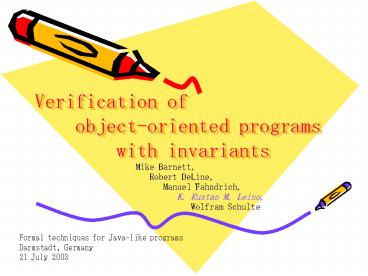Verification of object-oriented programs with invariants PowerPoint PPT Presentation
1 / 17
Title: Verification of object-oriented programs with invariants
1
Verification of object-oriented programs
with invariants
- Mike Barnett, Robert DeLine, Manuel
Fahndrich, K. Rustan M. Leino,
Wolfram Schulte
Formal techniques for Java-like
programsDarmstadt, Germany21 July 2003
2
Example problem
- class T int x, y invariant x lt y
- public void m(U u) x u.p() y
invariant assumed to hold
invariant may not hold
problem if p calls back into T
invariant re-established
3
WantedMethodology for invariants
- Ideal methodology
- easy to understand
- statically and modularly checkable
- identifies all errors in a program
- permits all good programs
4
Invariant declarationsone per subclass
- class W extends V int a int b
- invariant a b.length
Y y new Y()
Y
X
W
V
class V extends U P p invariant p ?
null
U
T
Object
5
Special field inv keeps track of which invariants
hold
o
o
o
W
W
W
V
V
V
U
U
U
T
T
T
Object
Object
Object
o.inv ?
o.inv U
o.inv W typeof(o)
o is consistent
- Declarations and statements of programminglanguag
e determine when inv is changed - The associated invariants are checked when inv
increases - To prevent established invariants from having to
bere-checked, one can treat fields in and below
o.inv asread-only
6
inv can be used inmethod specifications
- class T int x, y invariant x lt y
- public void m( ) requires inv T int
a new inty-x
meaning (?tT ? t.inv lt T ? t.x lt t.y)
invariant holds here (checked at call sites)
7
inv can be used inmethod specifications
- class T int x, y invariant x lt y
- public void m( ) requires inv
typeof(this) int a new inty-x
meaning (?tT ? t.inv lt T ? t.x lt t.y)
invariant holds here (checked at call sites)
8
Exposed vs. owned
o
o
o
o
owned
W
W
W
W
V
V
V
V
U
U
U
U
T
T
T
T
Object
Object
Object
Object
o.inv W
o.inv ?
o.inv U
o.inv W
consistent
consistent
exposed
owned
- Only consistent objects can be owned
- Special field exposed keeps track of
exposed/owned - exposed can be used in method specifications
9
Components
Q
Object
R
W
q
P
x
26
Object
V
p
U
T
Object
10
Components
Q
Object
R
q
P
x
26
Object
p
- Component fields are declared as such
- Component fields are not necessarily unique
references
U
T
Object
11
Components
Q
Object
owned
R
q
P
x
26
Object
p
- When inv is increased to U, then Us components
are checked to be consistent (p.inv typeof(p))
and are subsequently un-exposed
U
T
Object
o.inv U
o.inv T
12
Components
Q
Object
owned
R
q
P
x
26
Object
p
- Decreasing inv below U exposes Us components
U
T
Object
o.inv U
o.inv T
13
Fields of componentscan be mentioned in
invariants
k
Q
Object
h
g
R
q
P
x
26
Object
p
class U invariant x p.g ? p.g
p.h invariant x q.k
U
T
Object
- Fields of owned (un-exposed) objects are not
allowed to be mutated
14
License to modify
- A field o.f can be modified only when o.exposed
holds - A method m is allowed a net effect on a field o.f
(including o.inv and o.exposed) only if - o.f appears in the modifies clause of m, or
- o was not allocated on entry to m, or
- o was not exposed on entry to m
new
15
Method calls may change fields of un-exposed
objects
o
owned
h
g
R
P
x
26
Object
p
class U invariant x p.g ? p.g p.h
U
T
Object
16
Related work
- rep types in CLU
- valid idiom in ESC/Modula-3
- (implicit) pack/unpack operations in Vault and
Fugue - capability calculus
- ownership types
- invariant declarations in ESC/Java and JML
- locking and monitor disciplines in concurrent
programming
17
Conclusions
exposed
inv
Object
- Simple!
- inv, exposed, identification of components,
protocol for changing inv/exposed - object references can always be copied
- but objects can have just one owner
- fields can always be read
- but curbed expectations about the values read
- frame problem solved without abstraction (e.g.,
data groups) - Want
- experience, understanding of limits
- extensions to support more good programs
- more detailed comparison with other work

